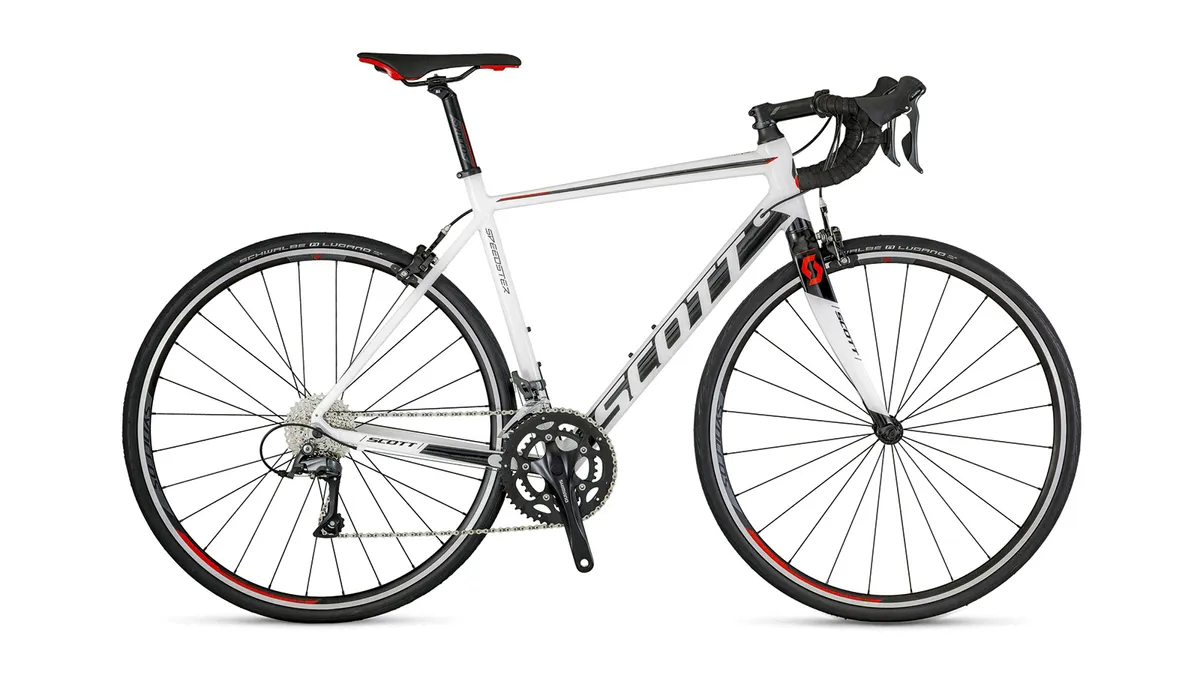Scott hasn’t always excelled at this price, but seeing as most bikes sold in Britain come in at well under £1000, get the product right and the customer will always keep coming back for more.
My hopes were raised when I saw that Scott’s entry-level Speedster 40 had been redesigned for 2018. Not only does it come in lighter than its predecessor, but it also has some neat features that are unusual on a bike at such a modest price.

True, a couple of the usual cost-cutting measures are evident when it comes to kitting out this bike, most notably the all-aluminium fork and budget non-cartridge Tektro brakes. But you can upgrade the brakes’ performance easily and inexpensively by swapping for cartridge blocks.
Scott has also taken measures to counteract the potential harshness of the all-metal fork by speccing 28mm Schwalbe tyres compared with last year’s 25mm Kendas. Yep, it looks like 28mm could be the new 25mm, which was of course the new 23mm...
Scott Speedster 40 kit
The Luganos are decent enough training tyres, but get the Vernier callipers out and they measure 29mm on the Syncros rims. Remember, the wider the tyre the lower the pressure you can run it at without risking extra punctures.
The difference in running pressures between a 23mm and 28mm tyre isn’t marginal either, as Schwalbe recommends 115psi for an 85kg rider on a 23mm tyre but just 94psi for 28mm rubber and a mere 80psi for a 60kg rider. This means you really can run the Speedster’s tyres at a lower pressure, for extra cushioned softness in the Scott’s firmish ride.

Another plus are the mudguard fittings — even with 28mm tyres there’s clearance for proper full-length mudguards, not just aftermarket blades. Mudguard fittings aren’t expensive to manufacture, but they increase a bike’s practicality on our notoriously wet island. I would have appreciated rear rack mounts, which Specialized manages on its Allez, but you can still attach rack fittings or use seatpost-mounted systems.
Another welcome change for 2018 is the move to a 32-tooth sprocket compared with last year’s 30. The real-world difference on my 16-mile commute, between a 32- and the 28-tooth sprocket on many entry-level road bikes, is being able to stay in the saddle on double-digit inclines, standing on the pedals or weaving about in a painfully slow zigzag. It could easily be the difference between riding and walking. The only penalty is bigger jumps between gears.

While Scott describes the geometry as ‘endurance’, the wheelbase is a touch shorter than last year’s, but I reckon the resulting geometry is pretty much spot on —it makes the Speedster sharp enough for speedier riders, and relaxed enough for the more leisurely minded.
I would have liked a carbon fork, but have no qualms about the handling. You can fly down hills and change direction rapidly, and the move to wider tyres and a wide-ranging cassette is a very sensible one by Scott, and one that’s designed to appeal to newer riders.



